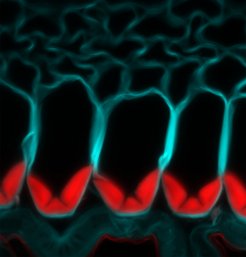Copper makes seed pods explode
Researchers identify the genes controlling the mechanical structure of exploding seed pods
Plants have evolved numerous strategies to spread their seeds widely. Some scatter their seeds to the wind, while others tempt animals and birds to eat their seed-filled fruits. And a few rare plants – such as the popping cress Cardamine hirsuta – have evolved exploding seed pods that propel their seeds in all directions. In their new study published in PNAS, Angela Hay and colleagues – from the Max Planck Institute for Plant Breeding Research in Cologne, Germany – investigate what genes control the mechanical structure of these exploding seed pods. Their findings show that a key micronutrient – copper – is essential for laying down a precise pattern of lignin in the seed pods. Lignin is an abundant plant polymer found in lignocellulose, the main structural material in plants. It is present in plant cells walls and is responsible for making wood stiff.

C. hirsuta seed pods consist of two, long valves. When the seeds are ready for dispersal, these valves rapidly separate and coil back, firing seeds out across a large area. The secret to these pods explosive nature is their unique mechanical design, which features three stiff rods of lignin connected by hinges. These hinges are crucial for the explosive release of potential energy stored in the pod. To create these hinged structures, lignin is deposited in a precise pattern in a single layer of seed pod cells, called endocarpb.
As Hay explains, "The mechanical design that allows these pods to explode depends on lignin being laid down in a precise pattern in this single layer of cells. We know little about what controls this pattern of lignin deposition, and so we set out to identify the genes that control this process. We found three genes that are required to lignify the cell wall in exploding seed pods. These genes code for enzymes, called laccases, that polymerize lignin. When C. hirsuta plants lack all three laccase genes, they also lack lignin in this specific cell type."
The research team also discovered another gene, called SPL7, required for C. hirsuta seed pod lignification. This gene encodes a protein that regulates copper levels in plants. The researchers discovered SPL7 in a mutant screen. Mutant plants that lack this gene, also lack lignin in endocarpb cell walls. Without lignin, they could no longer disperse their seeds widely. These effects were reversed when the SPL7 mutant plants were grown in soil with high copper levels, but not when they were grown in soil with low copper levels. SPL7 therefore helps C. hirsuta plants to acquire enough copper to develop fully exploding seed pods, especially when copper levels are low.
But how does copper affect the mechanical structure of these exploding seed pods?
Interestingly, laccases are copper binding proteins that depend on copper for their function. "The link between these two findings is copper", says Hay. "Plants need SPL7 to cope when there’s too little copper in the soil, and laccases need to bind copper for their enzymatic activity. Since lignin is critical for the mechanics of exploding seed pods, and copper-requiring laccases regulate this lignification, this makes seed dispersal dependent on the control of copper levels by SPL7."
These findings provide important new insights into the genes and cellular processes that generate these extraordinary exploding structures. They also shed new light on the role of copper in this process and on the process of lignification itself, which remains little understood. One reason for this is that large families of genes are involved in lignin polymerization in plant cell walls. Working out how each gene is involved is therefore a challenge, but one that could be addressed using approaches reported in this study, such as CRISPR/Cas9 gene editing and conditional gene expression.
Copper deficiency in soil affects plants and trees in many different ways and is tackled by using copper fertilisers. It is a particular problem for forestry, as low copper levels can cause tree weakening as a result of poor lignification. "Our work makes a molecular link between copper and lignin via SPL7 and laccases. These insights could inspire new approaches for sustainable forest management," Hay explains.
These findings might also be important for the more sustainable production of biofuels in the future. Lignified cell walls pose a challenge for biofuel production as they are resistant to degradation and so need to be broken down using expensive and energy-intensive pre-treatments. Hay notes, "Our work identifies three laccases that control lignification in a specific cell type. Understanding the genetic control of lignin polymerization across different cell types and plant species may open new frontiers in bioenergy based on cell wall engineering."












